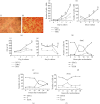p130 And pRb in the Maintenance of Transient Quiescence of Mesenchymal Stem Cells
- PMID: 33014072
- PMCID: PMC7519995
- DOI: 10.1155/2020/8883436
p130 And pRb in the Maintenance of Transient Quiescence of Mesenchymal Stem Cells
Abstract
An effective regulation of quiescence plays a key role in the differentiation, plasticity, and prevention of stem cells from becoming malignant. The state of quiescence is being controlled by the pRb family proteins which show overlapping functions in cell cycle regulation; however, their roles in controlling the proliferation of mesenchymal stem cells (MSCs) remain to be understood. This study investigated the regulation of transient quiescence using growth curves, proliferation assay, the cytometric evaluation of cell cycle, Western blotting, and the electromobility gel shift assay (EMSA) on synchronized MSCs of the C3H10Т1/2 and control cells with different statuses of pRb proteins. It has been found that functional steady-state level of p130 but not pRb plays a critical role for entering, exiting, and maintenance of transient quiescence in multipotent mesenchymal stem cells.
Copyright © 2020 Boris Popov et al.
Conflict of interest statement
No conflicts of interest, financial, or otherwise are declared by all authors.
Figures




Similar articles
-
pRb-E2F signaling in life of mesenchymal stem cells: Cell cycle, cell fate, and cell differentiation.Genes Dis. 2014 Sep 30;1(2):174-187. doi: 10.1016/j.gendis.2014.09.007. eCollection 2014 Dec. Genes Dis. 2014. PMID: 30258863 Free PMC article. Review.
-
Expression of the retinoblastoma family of tumor suppressors during murine embryonic orofacial development.Orthod Craniofac Res. 2003 Feb;6(1):32-47. doi: 10.1046/j.1439-0280.2003.2c035.x. Orthod Craniofac Res. 2003. PMID: 12627794
-
RB and RB2/p130 genes demonstrate both specific and overlapping functions during the early steps of in vitro neural differentiation of marrow stromal stem cells.Cell Death Differ. 2005 Jan;12(1):65-77. doi: 10.1038/sj.cdd.4401499. Cell Death Differ. 2005. PMID: 15459751
-
Activity of the retinoblastoma family proteins, pRB, p107, and p130, during cellular proliferation and differentiation.Crit Rev Biochem Mol Biol. 1996 Jun;31(3):237-71. doi: 10.3109/10409239609106585. Crit Rev Biochem Mol Biol. 1996. PMID: 8817077 Review.
-
Role of RB and RB2/P130 genes in marrow stromal stem cells plasticity.J Cell Physiol. 2004 Aug;200(2):201-12. doi: 10.1002/jcp.20026. J Cell Physiol. 2004. PMID: 15174090
References
LinkOut - more resources
Full Text Sources

